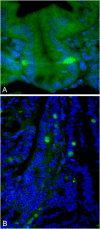Mouse models for colorectal cancer
- PMID: 23841024
- PMCID: PMC3696531
Mouse models for colorectal cancer
Abstract
Colorectal cancer (CRC) is the third leading cause of cancer-related death in the United States, with the number of affected people increasing. There are many risk factors that increase CRC risk, including family or personal history of CRC, smoking, consumption of red meat, obesity, and alcohol consumption. Conversely, increased screening, maintaining healthy body weight, not smoking, and limiting intake of red meat are all associated with reduced CRC morbidity and mortality. Mouse models of CRC were first used in 1928 and have played an important role in understanding CRC biology and treatment and have long been instrumental in clarifying the pathobiology of CRC formation and inhibition. This review focuses on advancements in modeling CRC in mice.
Keywords: Apc; Colorectal cancer; FAP; HNPCC; human; mouse models; stem cells; tumorigenesis.
Figures


Similar articles
-
A search for germline APC mutations in early onset colorectal cancer or familial colorectal cancer with normal DNA mismatch repair.Genes Chromosomes Cancer. 2001 Feb;30(2):181-6. Genes Chromosomes Cancer. 2001. PMID: 11135435
-
TRIB3 Interacts With β-Catenin and TCF4 to Increase Stem Cell Features of Colorectal Cancer Stem Cells and Tumorigenesis.Gastroenterology. 2019 Feb;156(3):708-721.e15. doi: 10.1053/j.gastro.2018.10.031. Epub 2018 Oct 24. Gastroenterology. 2019. PMID: 30365932
-
Primary and secondary prevention of colorectal cancer.Clin Med Insights Gastroenterol. 2014 Jul 14;7:33-46. doi: 10.4137/CGast.S14039. eCollection 2014. Clin Med Insights Gastroenterol. 2014. PMID: 25093007 Free PMC article. Review.
-
Association between red and processed meat intake and mortality among colorectal cancer survivors.J Clin Oncol. 2013 Aug 1;31(22):2773-82. doi: 10.1200/JCO.2013.49.1126. Epub 2013 Jul 1. J Clin Oncol. 2013. PMID: 23816965 Free PMC article.
-
Advances in Identification of Susceptibility Gene Defects of Hereditary Colorectal Cancer.J Cancer. 2019 Jan 1;10(3):643-653. doi: 10.7150/jca.28542. eCollection 2019. J Cancer. 2019. PMID: 30719162 Free PMC article. Review.
Cited by
-
Matrix Metalloproteinase Inhibitors in Cancer Therapy: Turning Past Failures Into Future Successes.Mol Cancer Ther. 2018 Jun;17(6):1147-1155. doi: 10.1158/1535-7163.MCT-17-0646. Epub 2018 May 7. Mol Cancer Ther. 2018. PMID: 29735645 Free PMC article. Review.
-
EGFR-targeted nonviral NIS gene transfer for bioimaging and therapy of disseminated colon cancer metastases.Oncotarget. 2017 Sep 16;8(54):92195-92208. doi: 10.18632/oncotarget.21028. eCollection 2017 Nov 3. Oncotarget. 2017. PMID: 29190908 Free PMC article.
-
STAT3β controls inflammatory responses and early tumor onset in skin and colon experimental cancer models.Am J Cancer Res. 2014 Sep 6;4(5):484-94. eCollection 2014. Am J Cancer Res. 2014. PMID: 25232490 Free PMC article.
-
Murine Models of Intraperitoneal Perfusion for Disseminated Colorectal Cancer.J Surg Res. 2019 Jan;233:310-322. doi: 10.1016/j.jss.2018.07.063. Epub 2018 Sep 5. J Surg Res. 2019. PMID: 30502264 Free PMC article.
-
Experimental Murine Models for Colorectal Cancer Research.Cancers (Basel). 2023 Apr 30;15(9):2570. doi: 10.3390/cancers15092570. Cancers (Basel). 2023. PMID: 37174036 Free PMC article. Review.
References
-
- Ferlay J, Shin HR, Bray F, Forman D, Mathers C, Parkin DM. Estimates of worldwide burden of cancer in 2008: GLOBOCAN 2008. Int J Cancer. 2010;127:2893–2917. - PubMed
-
- Jemal A, Siegel R, Xu J, Ward E. Cancer statistics, 2010. CA Cancer J Clin. 2010;60:277–300. - PubMed
-
- Chirica M, Leconte M, Oberlin O, Dousset B. Surgical treatment of liver metastasis in patients with colorectal cancer. Presse Med. 2012;41:58–67. - PubMed
-
- Fearon ER, Vogelstein B. A genetic model for colorectal tumorigenesis. Cell. 1990;61:759–767. - PubMed
-
- Vogelstein B, Fearon ER, Hamilton SR, Kern SE, Preisinger AC, Leppert M, Nakamura Y, White R, Smits AM, Bos JL. Genetic alterations during colorectal-tumor development. N Engl J Med. 1988;319:525–532. - PubMed
Grants and funding
LinkOut - more resources
Full Text Sources
Other Literature Sources
Miscellaneous
